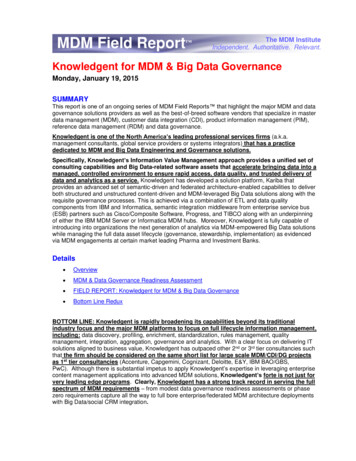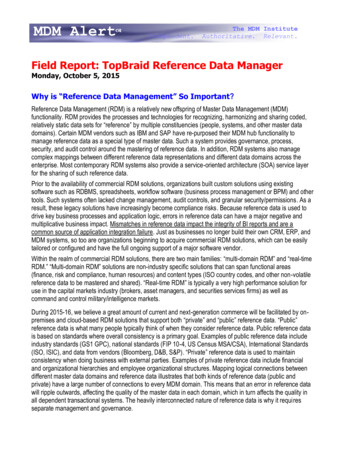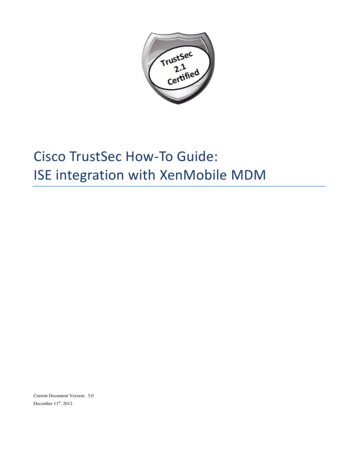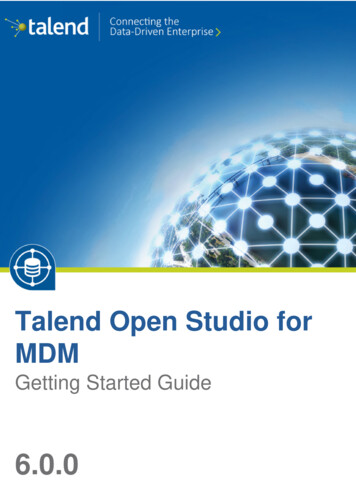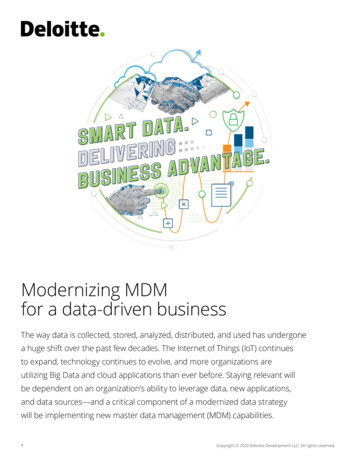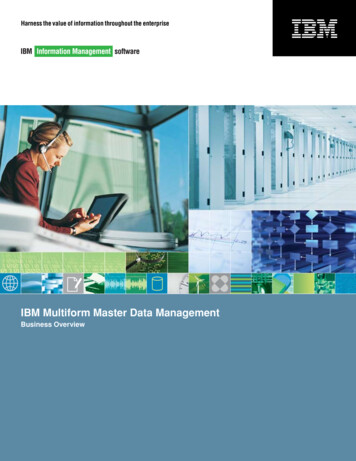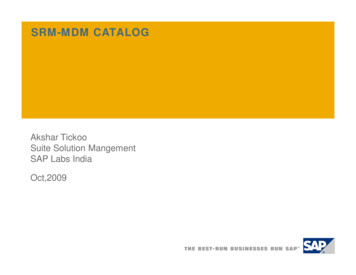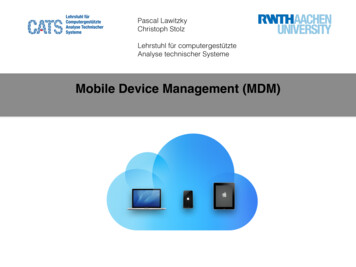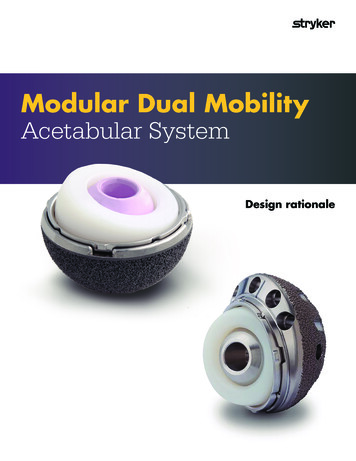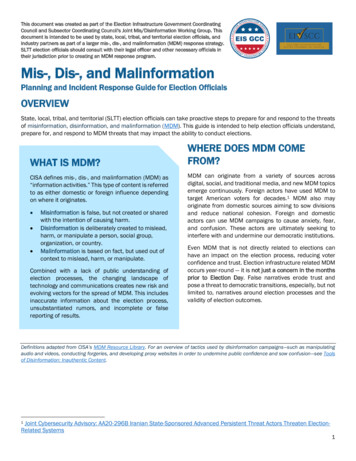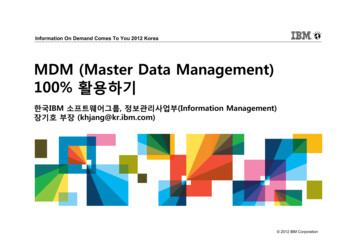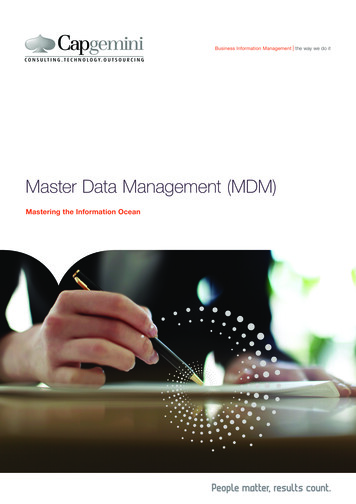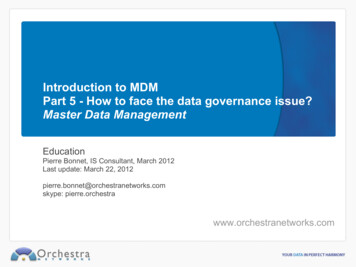
Transcription
Introduction to MDMPart 5 - How to face the data governance issue?Master Data ManagementEducationPierre Bonnet, IS Consultant, March 2012Last update: March 22, 2012pierre.bonnet@orchestranetworks.comskype: pierre.orchestrawww.orchestranetworks.com
ObjectiveHow to face the data governance issue? Data governance goals Definition of user roles for the data governance Meta data repository Governance repository and data approval workflow Procedures to oversee data values
Data governance goalsMastering data semantics Sharing data meanings and use across an Information SystemMastering responsibilities applied to data Owner, Author, Auditor, etc.Mastering procedures to oversee data What happens when a data value changes
RolesData OwnerResponsible for the data semanticEnforce the validation of semantic data modelsData AnalystIn Business department - achieve or contribute to enforce the semantic data modelingIn IT department - achieve or support business Data AnalystData ArchitectResponsible for the data quality across an Information SystemEnforce the Enterprise Data ArchitectureData AccountantResponsible for data management budgetEncourage and establish an innovative data P&L and data auditing approachData StewardOperational users in charge of authoring data values
Mastering data semanticsMeta data repository
Knowledge managementPut into a business and shared repository all semantics ofadministered items Business object Business rule Field ProcessThe better place to govern this knowledge is a MDM system itselfbecause Meta data master dataEg. in next slides
Description of an administered itemEg. business object 'Customer' (1/2)SynonymsGovernance roles
Description of an administered itemEg. business object 'Customer' (2/2)Semantics
Governance rulesWho is in charge of what indata governance across a company?
Portfolio of functions involved in data governance processesTo be defined depending on a company's needsSome COBIT functions
RACI procedure reminder
Definition of RACI crossed by administered item, function and users roles
List of RACI by administered itemEg. Customer business object is governed through four RACI
Synthesis of concepts used to establish data governance
Global RACI matrixAlignment of data workflow with the RACIAccountable Create working data version in order to ensure that further data modification will not impactproduction environment directly Decide when the working data version can be merged to the production data versionResponsible Regular data authoring Ability to merge a version of data to the production data version on requests by user acting asaccountableConsultedInformed Receive an approval task without any other data authoring permission Depending on the response the process can be stopped or carried out Under the scene a full audit trail of responses is enforced Receive email of other events without impacting the process
Alignment of data workflow with the RACI matrixEg. registered item Product's priceData OwnerAccountableResponsibleData StewardData AnalystData ArchitectCreate working branch- Approve the data mergingfrom working branch toproduction branchData authoring in theworking branch created bythe Data Owner - Doing themerge when the DataOwner has approvedmodificationConsultedemail after merging inproduction branchInformedemail in case of errorduring the process ofmodification
Data overseeingProcedures to oversee data values
GoalsOverseeing master data is targeted in priority as other transactionaldata should benefit from the supervision enforced by businesstransactions within applications When master data repository is managed with help of a MDM systemit is easier to set up business rules over the data repository tooversee data values in real time
Examples (1/2)Overseeing a customer's address can be very complicated when it isduplicated within several databases without a real master repositoryConversely, when using a MDM system to manage customers' addressesin complement with existing databases, it is easier to set up businessrules over the MDM repository such as when the customer's address is updated more than threetimes within a month then send a real-time alert to the salesdepartment
Examples (2/2)In a financial system when this rule is not fully enforced then a real-timealert is thrown to managers financial classification codes mustn't be modified more the Xtimes within a Y period of time
How to manage such rules on data values?Implementing these real-time rules requires a Complex EventProcessing approachThen users can both define real-time rules without any impact on regularexecution of the MDM system and can subscribe to events depending ontheir needs and permissions about data overseeing feeds of events social MDM wall MDM
What CEP is?CEP (Complex Event Processing) is complementary to BRMS(Business Rules Management System) it allows to enforce an active overseeing of data in real time the BRMS waits for an invocation coming from the MDM whereas theCEP listens to the MDM repository and executes rules depending ondata behaviors from an IT point of view, the integration of CEP with a MDM systemdepends on the ability of this MDM to publish in real-time a full datalog containing a detailed description of modifications applied to datavalues
This presentation didn't tackleYour own company's needs Based on data governance concepts defined here a progressivedesign of your own functions, processes and users roles cannot beavoidedThis presentation integrates these standardsISO 11170 (Data repository)RACI and COBIT (Governance)
To get further informationPlease attend the sixth part of this MDM introduction training courseThis part is dedicated to the business object's life-cycle modeling
Stay tunedpierre.bonnet@orchestranetworks.comskype: pierre.orchestrawww.orchestranetworks.com
RACI and COBIT (Governance) To get further information Please attend the sixth part of this MDM introduction training course This part is dedicated to the business object's life-cycle modeling . Stay tuned pierre.bonnet@orchestranetworks.com skype: pierre.orchestra
